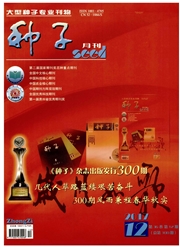

 中文摘要:
中文摘要:
以乌拉尔甘草1年生实生苗为实验材料,选取Na Cl、Na2SO4和Na HCO33种不同浓度的单盐,采用水培法对其进行30天的盐胁迫处理。盐胁迫结束后对株高、根长、根生物量、植株总生物量及叶面积进行测量,结合石蜡切片技术和扫描电镜技术对叶片显微结构及叶片表面进行观察,测量叶片厚度,统计气孔密度及腺体密度,比较不同盐胁迫对植株生长的影响,观察乌拉尔甘草对不同盐分胁迫环境的形态和结构响应。结果表明,3种盐对乌拉尔甘草幼苗生长的盐害作用强弱顺序为Na HCO3〉Na Cl〉Na2SO4。Na2SO4处理极显著地促进了乌拉尔甘草根生物量和植株总生物量的积累,且随盐浓度的升高促进作用呈增加的趋势。中浓度的Na2SO4处理促进了株高的增长和根的伸长,其余浓度则呈不同程度的抑制效果。高浓度Na2SO4处理使叶片栅栏组织细胞层数增多,因此叶片厚度和比叶重相应增加。中、低浓度Na Cl处理的植株总生物量显著小于对照组,但对根生物量未造成显著影响。高浓度Na Cl处理促进了乌拉尔甘草根系的发育和根生物量的积累,使总生物量显著增加。Na Cl处理条件下的叶面积和叶片厚度显著减小。Na HCO3浓度〉50 mmol/L时植株无法存活,浓度≤50 mmol/L的处理对株高和根长无显著影响,但有助于乌拉尔甘草根生物量和总生物量的积累。25 mmol/L处理显著抑制了叶片面积的增大,使叶片增厚,比叶重增加。3种单盐胁迫均促进了叶表面气孔的分化,但抑制了叶表面腺体的发育。
 英文摘要:
英文摘要:
Objective:The objectives were to research the response of Glycyrrhiza uralensis on morphology and structure under different salt stress environment. Methods:Taking Glycyrrhiza uralensis Fisch as materials. By the method of hydroponics, seedlings solution with different concentration height, root length, root biomass, total and gland density by technology of were cultured in plastic pots filled with a complete Hoagland nutrient of NaHCO3, NaCl and Na2SO4. After 30 days, we measured the plant biomass and leaf area. We determined the leaf thickness, stomatal density paraffin section and scanning electron microscopy. Result: There were different growth inhibition of Glycyrrhiza uralensis under three kinds of salt stress. The damage strength of salt stress was NaHCO3 〉 NaCl 〉 Na2SO4. With the increasing of Na2SO4 concentration,the root biomass and total biomass were highly significant increased. Middle concentration of Na2SO4 had promoted the plant height and root length increased. High concentration of Na2SO4 make the layers of palisade tissue cell increased, so the leaf thickness and specific leaf weight were increased. The total biomass was significantly less than the control group under the middle and low concentration of NaCl, but did not significantly influenced the root biomass. High concentration of NaCl treatment promoted the root length and root biomass accumulation, so that the total biomass significantly increased. Under NaCl treatment, the leaf area and leaf thickness significantly decreased. There were no plants survived under high concentration of NaHCO3 treatment ( 〉 50 mmool/L) , but low NaHCO3 treatment ( ≤50 retool/L) were conducive to root biomass and total biomass accumulation. The 25 mmol/L NaHCO3 treatment significantly inhibited the leaf area increased, so the leaf thickness and leaf weight ratio were increased. Three kinds of single salt stress could promoted the differentiation of leaf stomata, but inhibited the leaf glandular growth.
 同期刊论文项目
同期刊论文项目
 同项目期刊论文
同项目期刊论文
 期刊信息
期刊信息
